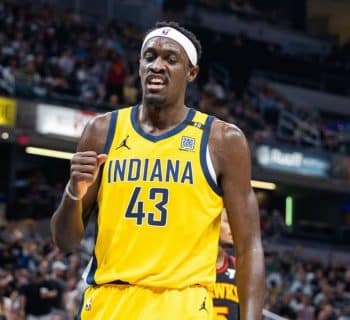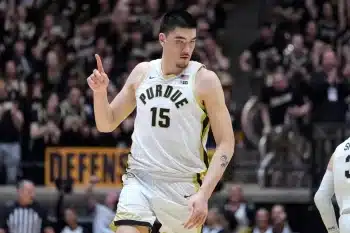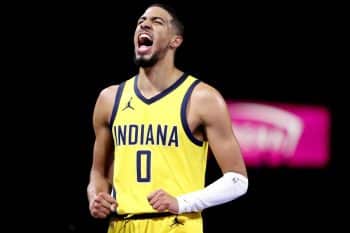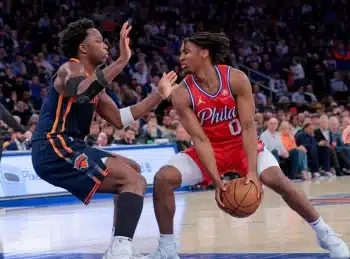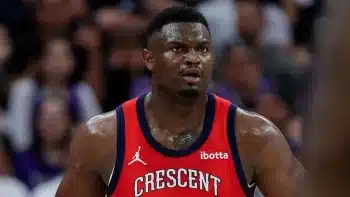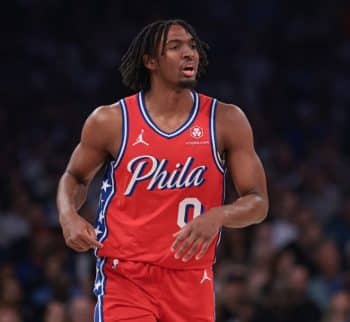NBA
NBA AM: Why Some Guys Are Bad Foul Shooters

If you have been watching the NBA playoffs, it’s hard not to notice that there are some really bad free throw shooters around the league and the majority of them seem to be big guys.
Detroit’s Andre Drummond went 32.4 percent from the foul line in the Pistons’ series against the Cavaliers. Clippers big man DeAndre Jordan has shot 32.5 percent from the line versus the Trail Blazers. Cleveland’s Tristan Thompson went 33 percent versus the Pistons, while Houston’s Dwight Howard went 35.3 percent from the line versus the Warriors.
In fact, of the 35 players classified as center who have logged playoff minutes, only 13 of them are shooting above 60 percent from the line.
There are a lot of theories on why these guys struggle so much from the charity stripe. Some try to say that they don’t work hard enough to improve. Some say they are too tall to make the shooting trajectories smaller players can make. Some point to hand size. There is even data saying foot size may play a factor too.
The problem with a one-size-fits-all story is that some big men are actually very good free throw shooters. So to get a better handle on what’s going on, Basketball Insiders reached out to a couple of people for their insight.
One is noted NBA skills trainer Dan Barto of IMG Academy. The other is a well-traveled coach who played professionally, has worked with hundreds of NBA players and currently works for a Western Conference team in the playoffs. His particular team wouldn’t look too kindly on him being on the record on this topic, so we’ll just call him a “source.”
The debate about how to fix a bad free throw shooter has raged on for years. Some of the best big men in the game’s history were terrible free throw shooters, so this is nothing new. But with an ever-growing understanding of biomechanics, human physiology and a lot of new technology there might be a better understanding for how some of the guys in the current crop can get better.
“If you watch Dwight Howard, DeAndre Jordan, Hassan Whiteside and obviously Andre Drummond, they usually have oversized plus-15-sized feet and they do not get the energy off of the ground,” Barto said. “If you watch all of their free throws, they do not… When you shoot, you have to step in and you basically push your toes into the ground; your heel comes up and then you lift off the ground and that sends the energy up through your body. You then just kind of control the energy, keep your elbow in and science sort of takes over.”
That’s not happening for many of the NBA’s best big men when they are shooting free throws.
“They don’t even get up onto their toes,” Barto said after watching hours of bad free throws looking for trends to help his current group of players. “They’re taking their two or three dribbles and every single time they create energy a different way. Sometimes they come up a little bit and create a little bit of energy. If they don’t come up at all, then the energy doesn’t start until the knee bends. You don’t know what percentages of your muscles are being used there. So as the energy goes up the chain, they are constantly doing different things. Their arms have to be tight and they end up just throwing the ball, even though if you moved them over to the elbow and had them shoot jump shots [from the same distance], they would be way more consistent because they would be leaving the ground and the energy would be coming off the ground the same way every single time.
“If you go and pull all of their free throws, you can literally see them never push up onto their toes and use their calf muscles at all. If you could attach things to measure the energy, every energy reading would be different… Moe Harkless [who trains with Barto at IMG Academy] did the same thing. Moe would go up really, really quickly and then come down quickly. He wouldn’t go up and hold on his toes, so the energy wasn’t controlled. He would go up and down, he would shoot the energy up and only in the last three weeks, basically since he became a starter, has he been able to make the adjustment. He’s gone from the mid-50s to over the low 70s percentage wise in those three weeks.”
Harkless has improved from 52 percent prior to making changes to his free throw process to just over 72 percent from the line after making leg energy adjustments around the All-Star break. Those changes did not come easy, since changing long-installed habits in the heat of a game is tough.
“You can’t stand there next to the guy after he’s been fouled hard and convince him that staying up on his toes is going to make the difference,” Barto said of installing a new free throw shooting process.
Barto has been a long-time proponent of bio-mechanical analysis and he incorporates a lot of bio-science into his basketball training techniques at IMG, but the free throw issue is more than just a scientific problem.
Our Western Conference coach said that big men often point to their hand size as the biggest reasons for their struggles from the line.
“The classic answer has always been about hand size,” he said. “The size of their hands makes it a little more difficult to comfortably hold the ball. That’s not to say that I think that is a great assessment, because there are some big guys who have a soft touch as far as free throws go, but that’s the main complaint I have heard about big guys being poor free throw shooters.”
Understanding the physiology is important, but our West coach also pointed out that a player’s approach to the free throw concept matters too – especially for many of these guys who make a ton of shots in practice, but can’t replicate it in games.
“I think it’s about how you approach the moment,” the coach said. “I think that’s where these guys become really self-conscious about what’s already transpired, like for instance the percentage they already have. It’s kind of like being so far in the hole that you feel like you can’t dig your way out. You feel like you are that number. If your free throw percentage is 45 percent, you feel like you are a 45 percent free throw shooter, even though earlier that day maybe you knocked down 20-of-20 at one point in time. Now, you are going to the line and you are like a golfer trying to make a putt and any sort of negative energy is going to alter that shot.”
The mindset of the player matters too.
“You can’t go to the free throw line and tell yourself, ‘Make it. I’ve got to make it.’ You have to be more focused on the functionality of what you are doing,” the coach added. “The positive self-talk should be, ‘Just shoot it straight. Shoot it straight.’ What I personally always told myself at the free throw line, and I was like a 90 percent free throw shooter for my career, was, ‘If I shoot it straight and trust my work, the rest is going to fall into place.’ You can’t be result driven. You have got to be driven on your mechanics and whatever your form is.”
In what has become something of an annual NBA tradition, as soon as a player has a dreadful playoff showing at the foul line, someone points to Hall of Famer Rick Barry and his legendary underhanded shot as the answer. None of the experts seemed to agree, mainly because of the impact it would have on a player both in the media and among his peers.
“I don’t think physiologically you could ever get them to do that,” Barto said. “I think when Rick Barry did it, he had probably done it so many times; you know, thousands and thousands of times before that so he figured out how to control the energy and had really good awareness. By the time a guy got enough reps that way where he could control it, it wouldn’t be worth the time and energy.”
Barto’s belief is that most of the bad free throw shooters have poor or subpar body control, and changing the action likely wouldn’t yield appreciably better results because the core problem would still exist.
“I don’t think you can take a bad free throw shooter and make him over 70 percent [shooting underhand]. I do think you could take a good free throw shooter and teach him how to shoot underhand and he could be nearly as successful.”
Our veteran coach believes that shooting underhanded might not be the answer, but a change in shooting hands might be. This is something Thompson tried awhile back and it made plenty of headlines.
“I think before going to a ‘granny-style’ shot, a guy would switch from being a right-handed shooting player from the free throw line to a left-handed shooting player,” the coach said. “I think that’s less embarrassing. These guys have delicate feelings and that certainly plays a part in whether you go to a granny style shot because that will put more focus on it.”
Our coach also conceded he wouldn’t advocate any of his players taking up the underhanded shot.
“I don’t necessarily think I would,” the coach said. “I do think there is a solution for these guys. Teams have spent God knows how much money to work with them on this particular skill. I mean, there are guys who are feeding their family just off being shooting coaches, particularly free throw ‘experts.’ But the reality of it is there is still always an answer.”
There is another concept that’s gaining momentum in the decision to send bad free throw shooters to the line: analytics. More and more teams are tracking points per possession, or the points scored every time the team touches the ball. Bad free throw shooters are dragging down a team’s overall production, especially when so many guys are making less than one foul shot in four attempts. The truth is, if some of these players could even get to the 50 percent mark, that would be more productive than some set offensive plays in the points per possession department, which makes finding a solution to this problem all the more important.
The math says most of these guys don’t even need to be high-level free throw shooters, simply getting to the 50 percent mark negates the impact they have on the outcome of a game.
It’s easy to say that a particular player does not work enough. That’s an easy assertion to make, especially when fans don’t see the behind-the-scenes training. But, as many coaches and trainers will tell you, putting in the work is only part of the solution. Some of the problem is bio-mechanical. Some of it is a mental block that grows over time. Sometimes, it’s a combination of things.
What was clear in talking with coaches and trainers is that switching to an underhanded shot wouldn’t necessarily change anything because most players have never shot the ball that way in their life. So is it better to help a player refine a natural shooting action and help him correct flaws already there, or try to reinvent the entire process and potentially develop new flaws in his new form?
There are obviously some bad free throw shooters in the NBA, and a large many of them are tossing up bricks in the postseason. However, the reality is that there’s a lot more going on at the foul line than just not being focused or not putting in the work.
More Twitter: Make sure you are following all of our guys on Twitter to ensure you are getting the very latest from our team: @stevekylerNBA, @AlexKennedyNBA, @LangGreene, @EricPincus, @joelbrigham, @SusanBible @TommyBeer, @MokeHamilton , @jblancartenba, @eric_saar and @CodyTaylorNBA .